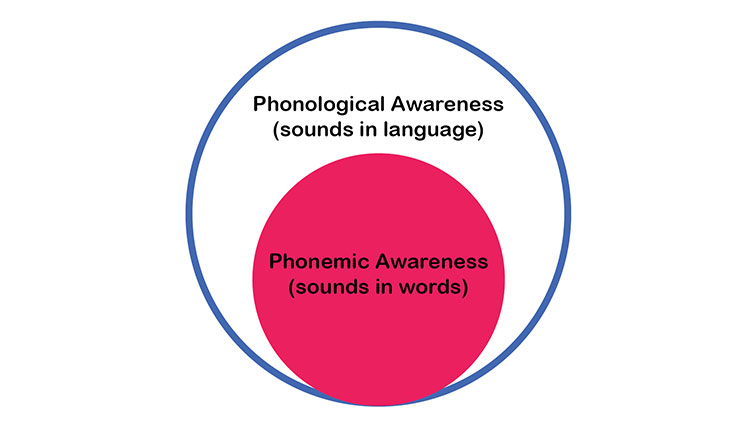Before You Start
1. Critical Concepts about Phonological Awareness
Please review these important points before diving in to the games in our curriculum. You can also print a hard copy to keep as a handy reference.
- Phonological awareness is not the same thing as phonics. It is the foundation that makes learning phonics possible!
- Phonological awareness refers to the sounds in language. It includes phonemic awareness. Phonemic awareness refers only to the sounds in words.
- Pure phonological awareness skills can be learned blindfolded; however, young children often benefit from pictures to help them understand phonological awareness tasks and activities.
- Always name all the pictures used in an activity before you begin teaching the lesson. This insures that everyone is using the correct word for each picture.
- Phonological awareness skills have a developmental hierarchy that is reflected in the modules of this curriculum. Refer to the Pacing Guide to see the ages at which the various skills usually develop.
- Blending sounds is easier for children than separating sounds. The lessons within the modules reflect this progression. Follow the scope and sequence of this curriculum—do not randomly skip around. You will get better results and less frustration.
- Review and practice previously learned skills while learning new ones. Children enjoy playing games they already know and are good at, and they will experience less frustration.

Phonemic Awareness is a subset within the larger concept of Phonological Awareness.
2. Where to Start
Refer to our Pacing Guide to get an idea of where in the curriculum you should start with your child.
Every child is different, of course, and the appropriate place to start will also depend on what schooling or training your child has already received.
Leave a Reply


5 Responses to “Before You Start”
Shandre
What should I teach my children first, the phonics or the sight words?
ADMIN – Hi Shandre,
I would introduce them at the same time. Phonics gives them strategies for new words. Sight Words gives them strategies for phonetically irregular words plus speed.
Susan Connick
Do you have a screener? What is the best way to get a baseline assessment & progress monitor?
ADMIN – Thanks for your question, Susan. The closest screening assessment we have found that aligns with our curriculum is Two Peas in a Pod. If you access Pacing, Assessment, and Fast Track on the home page, you will find a free download of this assessment tool under 3. There are several other screening assessments listed there, as well. Please contact us any time you have other questions or comments.
Hank
Advice please…
I am going to teach 5-7 year olds (EFL kids) with no foundation at all. Can I follow your website’s teaching procedure – phonological awareness first and then sight words in 60 classroom periods before phonics? Or give me some advice, please!
ADMIN – Hi Hank,
I would do the phonological assessment on the kids to see where they are. If they have no foundation, they are probably going to need the phonemic/phonological awareness section first. That is probably going to take you most of that 60 classroom periods. Once you have finished you can start doing some sight words and phonics.
GURUPRASAD C M
Students who are learning two to three languages at a time are having some difficulties in pronunciation.
Mia Evans
Thanks for pointing out that full phonological awareness skills can be easily learned, but it is easier for kids with pictures. I will make sure to find the right resources and programs that practice different teaching styles to ensure that my child will be able to read soon. He is almost 4 and will go to school soon, so I want to start him with learning to read as early as now to be prepared when going to school next school year. https://senseable.com/